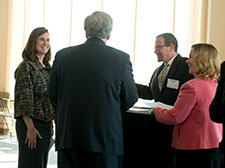Planting a Seed
New grants grow UMBCs research partnership with UMB
Faculty members at Maryland universities conduct important research that may provide relief for spinal cord injury victims, or develop new targeted methods to deliver drugs through nanotechnology.
More and more of that vital work is being conducted in collaborations between faculty at UMBC and the University of Maryland, Baltimore (UMB).
The latest venture to expand the research partnership between the two neighboring universities (separated by less than seven miles) is a joint UMBC-UMB Research and Innovation Partnership Seed Grant Program that pairs primary investigators from each university to conduct research as a team. Successful partners are offered research funding of up to $75,000 over twelve months to pursue their collaboration.
The programs first grant recipients were announced at a ceremony and poster session held at UMBCs Albin O. Kuhn Library on February 11, 2014. Those selected for the awards included faculty in UMBCs College of Natural and Mathematical Science and College of Engineering and Information Technology, as well as researchers in the University of Maryland School of Medicine and University of Maryland School of Pharmacy.
At the announcement ceremony, UMB Chief Academic and Research Officer and Senior Vice President Bruce Jarrell observed that the Seed Grant Program represents the deepening of a relationship that already includes cooperation on a joint graduate school and the Institute of Marine Environmental Technology (IMET) as well as a panoply of curricular efforts in areas such as the life sciences, gerontology, health informatics and social work.
These collaborations already exist, Jarrell observed. And were proud to have UMBC as a partner.
UMBC President Freeman A. Hrabowski, III, is enthusiastic about the projects selected for the initial round, which include investigations that may influence the course of research into cancer, strokes and muscle degeneration.
The Seed Grant Program is a means by which both universities can better discover each others strengths and needs to see how we can better collaborate, says Hrabowski.
Jay Perman, President of the University of Maryland, Baltimore, says increased partnership between the two universities is a key element of his vision. I cannot stress enough the importance we place on our collaborative relationship with our colleagues at UMBC. The partnerships that UMBC and UMB have enjoyed for years are real, longstanding collaborations, and have been extremely successful, if not widely known.
At the state level, the research partnerships fostered by the Seed Grant Program will further extend Marylands research profile and aid in securing vital funding from federal agencies, private foundations and other funding sources.
William E. Kirwan, Chancellor of the University System of Maryland (USM), praises the new program for its focus on cutting-edge science and health concerns and its emphasis on interdisciplinary teamwork.
It is this type of structured collaboration. Kirwan says, that will enable both UMBC and UMBas well as the USMto reach their full potential, and to take full advantage of the opportunities before us.
The first five teams to receive UMBC-UMB Research and Innovation Partnership Seed Grants are:
* Kathleen Hoffman, professor of mathematics (UMBC) and Asaf Keller, professor of anatomy and neurobiology (UMB), are exploring the chronic pain of patients with spinal cord injury and how computational modeling may help analyze the neurobiological changes in the central nervous system after such injuries.
* Martin Schneider, professor of biochemistry and molecular biology (UMB) and Bradford E. Peercy, assistant professor of mathematics (UMBC) are combining forces to analyze a transcription factor (Foxo1) in skeletal muscle that activates genes in a pathway that leads to the breakdown of muscle protein. They hope to develop protocols and models that will provide new approaches to controlling this factor.
* Charles Bieberich, professor of biological sciences (UMBC) and Paul Shapiro, associate professor of pharmaceutical sciences (UMB) are working on a more targeted use of a promising cancer treatment called kinase inhibition. Currently kinase inhibition creates resistance over time, so Bieberich and Shapiro are looking for more selective paths to inhibit portions of an enzyme that allows cancer cells to multiply without shutting down other functions in the process.
* Marie-Christine Daniel, associate professor of chemistry and biochemistry (UMBC) and Peter Swaan, professor of pharmaceutical sciences (UMB) are exploring how nanotechnology might improve the delivery of drugs (increased dosage, or better targeting) by examining a class of molecules known as dendrons.
* Tulay Adali, professor of computer science and electrical engineering (UMBC) and Kelly Westlake, assistant professor of physical therapy and rehabilitation science (UMB) are exploring how using a powerful computational tool (independent vector analysis) can aid in navigating variability in cognitive neural function and better help the recovery of stroke victims.
A call for proposals for the next round of the UMBC-UMB Research and Innovation Partnership Seed Grant Program will be issued on April 15, 2014.
(02/12/14)

